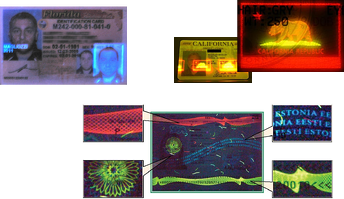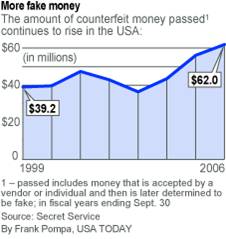
As technology advances and as more people become aware of the simplicity of digital
counterfeiting, the act of doing so is steadily increasing. Unfortunately, the majority of businesses do not have the proper processes or tools needed for detecting counterfeit bills.
Therefore, many companies experience financial losses that are easily avoidable, if the proper steps  are taken.
are taken.
Much of this loss could be prevented with the use of a counterfeit detector. Having a counterfeit prevention system in place is vital to your business.
Best Practices for Detecting
Counterfeit Money
With the amount of counterfeit money steadily increasing each year, it is more important than ever to understand what to look for and to implement an efficient counterfeit detector. Whether it be by physical inspection or through a specially designed tool, there are several options available.
Physical Inspection
This is the first line of defense against counterfeit bills. To locate a counterfeit note, there are specific security features to look for.
Color Shifting Ink

On the front lower right hand corner of the bill you will see a printed number. Slightly turn the bill back and forth and you will notice that the color of the ink will change from gray to green and vice versa.
Intaglio Printing

This type of printing causes the raised feel you notice when you slide your fingertips over money. It also produces intricate detailing which is seen on the print itself. Because the likelihood that a counterfeiter could produce both of these qualities is highlyimprobable, this is an ideal attribute to look for first.
Watermarks
Watermarks are often used on currency, but are very easy to replicate using graphics and word processing software. Therefore, watermarks are no longer a reliable security feature, so authenticity should not be based solely off of them.
Covert Feature Detection
For the covert features found on paper currency, those unseen by the natural eye, you will typically need a specially designed tool in order to verify the authenticity. There are several tools that can be used for this purpose.
Ultraviolet Inks
Since 1996, currency has been designed with UV inks which react to the proper wavelength of UV light. When activated by the appropriate light, the ink causes a fluorescent response which can be seen by the natural eye. Testing for ultraviolet fluorescence is less intrusive for customers, simple to use, effective and can be done at a low cost. Furthermore, it can be used on several types of documents such as currency, checks, ID documents and credit cards. For all of these reasons, this counterfeit detector is a top choice for small and large companies alike.
Magnifier
This is a magnifying glass which is used to examine documents for micro-printing. Many  counterfeit documents do not contain micro-printing. If they do the quality normally pales in comparison to that of real documents. With a magnifier you can see the intricate details on both offset and intaglio printed currency.
counterfeit documents do not contain micro-printing. If they do the quality normally pales in comparison to that of real documents. With a magnifier you can see the intricate details on both offset and intaglio printed currency.
Infra-Red Viewer
Currency is printed with infrared ink which is activated under infrared lighting. This is a small, but efficient tool which can be conveniently used during transactions.
Magnetic Ink Detector
This device looks for the magnetic ink printed on money. When the device detects the magnetic ink it will either light up or make a sound to indicate that the bill is authentic.
By incorporating the appropriate counterfeit detector for your business, you will drastically reduce the amount of financial loss you incur. Additionally, you can avoid administrative and criminal penalties which may occur due to strict compliance regulations. By carefully considering your company's needs, you can choose the right counterfeit detector for your business and stop fraud in it's tracks.


